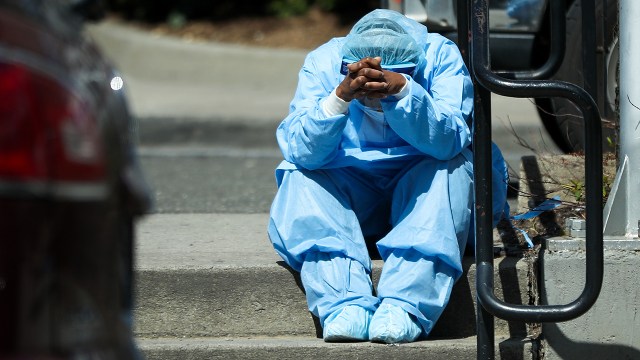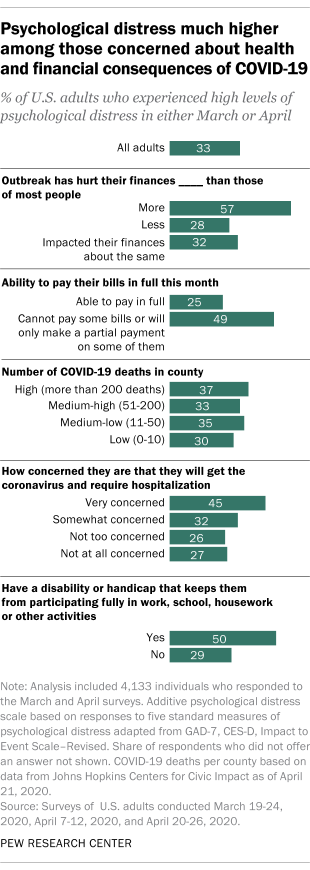
Note: For the latest information on this topic, read our 2022 post.
One-third of Americans (33%) have experienced high levels of psychological distress at some point during the extended period of social distancing undertaken to slow the spread of COVID-19, the disease caused by the novel coronavirus. More than half (55%) of adults who describe their financial situation as poor have experienced high levels of distress, as have half of those who report having a disability or handicap that keeps them from fully participating in work, school or other activities.

To help track and assess the mental health consequences of the COVID-19 outbreak, Pew Research Center asked members of its American Trends Panel in both March and April how often in the past seven days they had experienced five different types of psychological distress (such as anxiety, sleeplessness or depression). Based on responses to these questions, panelists were placed into three categories of psychological distress: high, medium or low. Because the questions were administered to the same individuals twice (once between March 19-24 and again between April 20-26) it is possible to see who changed and by how much. (See this analysis for more details about the questions and the index.)
How we did this
This assessment of the public’s psychological reaction to the COVID-19 outbreak is based on surveys of members of Pew Research Center’s American Trends Panel (ATP) conducted online three times during March and April. The mental health questions were included on two of the three surveys. The March survey was conducted with 11,537 U.S. adults March 19-24, 2020; a second survey with the question series was conducted April 20-26, 2020, with a sample of 10,139 adults, most of whom had been interviewed in March. In between these two, a survey was conducted April 7-12, 2020, with a random subset of 4,917 panelists, most of whom had been interviewed in March and April. This early April survey included an extensive set of questions about the financial and health consequences of the outbreak. Much of the analysis is based on the set of 9,545 responses to both the March and late April waves. Analyses of results of all three waves are based on 4,133 responses.
The ATP is an online survey panel that is recruited through national random sampling of residential addresses. This way nearly all U.S. adults have a chance of selection. The surveys are weighted to be representative of the U.S. adult population by gender, race, ethnicity, partisan affiliation, education and other categories. Here is more information about the ATP.
The psychological distress index measures the total amount of mental distress that individuals reported experiencing in the past seven days, which for the March survey was roughly the week after President Donald Trump’s March 11 Oval Office address about COVID-19. The late April survey corresponded with a period during which more than 2,000 deaths per day, on average, were reported in the U.S. The low distress category in the index includes about half of the sample; very few in that group said they were experiencing any of the types of distress most or all of the time. The middle category includes roughly one-quarter of the sample, as does the high distress category. A large majority of those in the high distress group reported experiencing at least one type of distress most or all of the time in the past seven days.
The questions used to measure the levels of psychological distress were developed with the help of the COVID-19 and mental health measurement group from Johns Hopkins Bloomberg School of Public Health (JHSPH): M. Daniele Fallin (JHSPH), Calliope Holingue (Kennedy Krieger Institute, JHSPH), Renee Johnson (JHSPH), Luke Kalb (Kennedy Krieger Institute, JHSPH), Frauke Kreuter (University of Maryland, University of Mannheim), Elizabeth Stuart (JHSPH), Johannes Thrul (JHSPH) and Cindy Veldhuis (Columbia University).
Here are the mental health questions and questions about panelists’ financial situation (additional question here) used for the analysis, along with responses, and the detailed survey methodology statements for March, early April, and late April.
The overall levels of psychological distress were nearly identical in both surveys, with about half in each month categorized as having a low level of distress on the scale, and roughly one-quarter each falling into the medium and high categories.

But stability in the overall levels of distress conceals considerable change at the individual level, with some people shifting from one category of distress to another. Overall, 33% of panelists fell into the high category of distress at one or both time points. From the March survey, 17% became more distressed (moving up at least one category in the three-category scale), while a roughly equal number (18%) became less distressed, moving down one or more categories; 15% were in the high distress category in March and remained there in April.
Because four of the five questions used to create the index did not refer specifically to the COVID-19 outbreak, it is impossible to know if the pandemic is a cause of the panelists’ psychological distress. Some underlying level of anxiety, sleeplessness, depression and other manifestations of distress exists even in normal times.
But people who experienced a high level of distress in either March or April are more likely than others to say that the pandemic has negatively affected their financial situation, that they are very concerned that they will get the coronavirus and require hospitalization, and that keeping up with the news about the coronavirus makes them feel worse emotionally. And those expressing concern about the financial impact of the outbreak were more likely than those less affected to become more distressed between March and April.
Financial troubles, worries about getting infected and proximity to active cases of the disease, as measured by the number of confirmed deaths in the panelist’s county as of April 21, correlated with whether a panelist experienced high levels of distress in either March or April. Among those who said their finances had been hurt by the outbreak more than those of most people, 57% had experienced high levels of distress. That compares with 32% among those who said their finances had been affected about the same as those of other people. Similarly, among those who said they cannot pay some or all of their bills or will only make partial payments, about half (49%) experienced high levels of distress; just one-fourth of those able to pay their bills in full (25%) had experienced high levels of distress.
Physical vulnerability to the outbreak is also strongly related to whether people are experiencing psychological distress. People living in counties with the highest numbers of COVID-19 deaths were more likely than others to experience high levels of psychological distress than those in counties with the lowest number of deaths. People expressing concern about becoming sick and hospitalized with the coronavirus had higher levels of distress: 45% among those who said they were “very concerned” compared with 27% of those who are “not at all concerned.” People who reported having a disability or handicap that limited their ability to participate fully in work or other activities were much more likely to experience high levels of distress (50%) than those who do not have a disability (29%).
Note: Here are the mental health questions and questions about panelists’ financial situation used for this report, along with responses, and the methodology for the March, early April, and late April surveys.